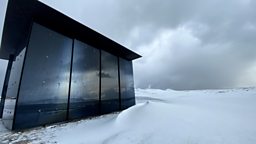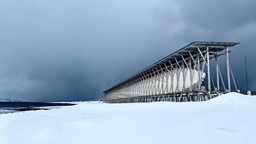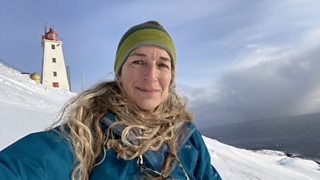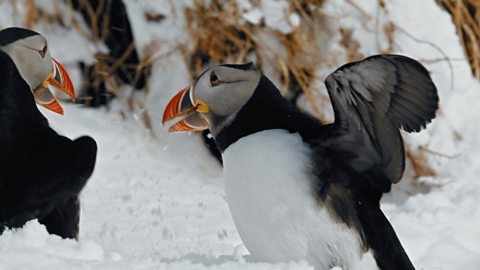Puffins and witches
By Tuppence Stone, series producer for Wild Scandinavia

It was a whiteout when I arrived in Vardo – a small settlement clinging to the arctic coast in northeastern Norway.

It’s the crossing point to the offshore island of Hornoya – where we were set to film a seabird spectacle – tens of thousands of puffins and guillemots, that arrive to nest each spring.
But covid had interrupted my trip, while the crew went ahead, I was stuck in Vardo, isolated with the desolate March weather.
In my isolation I explored Vardo’s bleak history – notorious for the Norwegian witch trials in the 1660s. I had read a bit about them, but wasn’t prepared for what I found as I set out to visit the town’s memorial.
I was alone in a blizzard, no other soul was visiting. Drift ridges were made crisp by the howl of the wind. Each footstep disappeared as I approached the memorial – a stark black cube with a hint of light within.


I entered the cube and saw that the source of light was fire, five wind-blown flaming jets, emerging blue from a steel chair with tips dancing orange.
unwittingly put in the position of the crowd who witnessed such horrific witch burnings
The flaming chair sat within a rough-hewn concrete ring - evocative of logs stacked around a pyre, teased by whisps of snow blown into the cube.
Above seven huge oval mirrors looked down, as if judging the condemned, reflecting the gruesome installation back to my eyes over and over, while through the darkened glass I saw the snowscape and crashing waves of the Arctic Ocean. I felt powerfully connected to the victims, unwittingly put in the position of the crowd who witnessed such horrific witch burnings.

Outside there was a second curious structure – like a large pale, bony fish. This fabric building was taught and suspended, caught within a solid frame of silvered beams, which looked like the fish drying racks of tradition here. Stormy skies and the weak winter sun wrapped around this evocative and haunting place.
91 bulbs - one for each of the 91 people who were executed for witchcraft
Along its length the fabric was pierced by small square windows looking out, but when I entered inside, the sensation was entirely transformed. The heavy metal door was forced closed by the wind. Inside the fabric structure was black.
Hanging along this thin corridor were bare bulbs, each by a small window letting in the outside - the sunlight, the view. 91 bulbs - one for each of the 91 people who were executed for witchcraft on this shore. Alongside each is a name and a simple description of their crimes – transformation into cats, flying, stealing wine, corrupting others to witchcraft, dancing with the devil.
Walking down the corridor, Sölve Nilsdotter, Kristi Sørensdatter, Else Knutsdatter burnt for sorcery. Through each tiny window, a view onto the swirling snow, the crashing waves on the shore. Just as each perspective is unique, no two lives destroyed were the same. From 1600-1692 witch-hunts persecuted Norwegians and Sami, especially women.

This space is not sealed from the outside. The fierce winds whip up through the slatted floor, the bulbs sway, the walls flex, almost breathe, distorting the noise of wind and sea. Together these two spaces created the most evocative and powerful memorials I have ever witnessed.

A few days later, as I left Vardo harbour, I crossed the same waters where many accused witches were subjected to an abominable trial of guilt. They were thrown, bound, into the sea for God’s judgement on their crimes. The sacred water would embrace the innocent and they would sink. Any that floated were being repelled by the water as evil. One third of those executed were subjected to the water ordeal, they all floated.
Finally on Hornoya, I was surrounded by chattering birds, full of life. Great flocks wheeled above me - a winged community making the most of this tough but rich coastline. My mind focused on filming once more, but puffins will always be linked with witches in my memory, as history and natural history merged in Vardo.

Puffins fight dirty!
A battle for survival in a crowded puffin colony.





